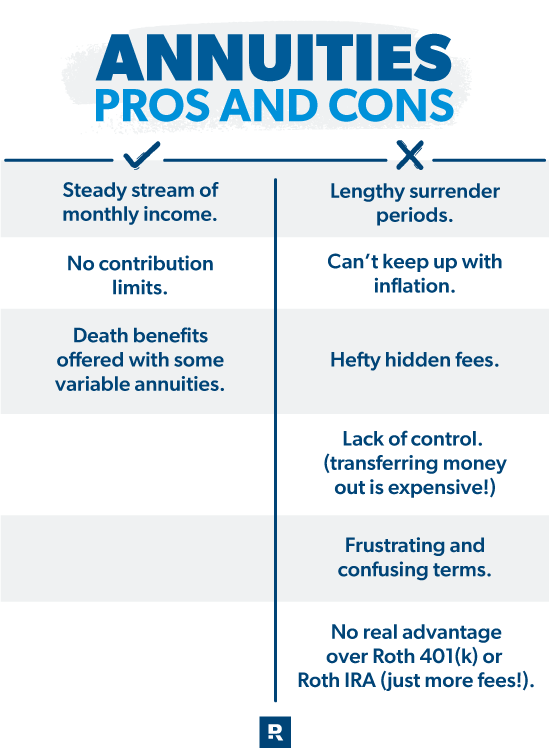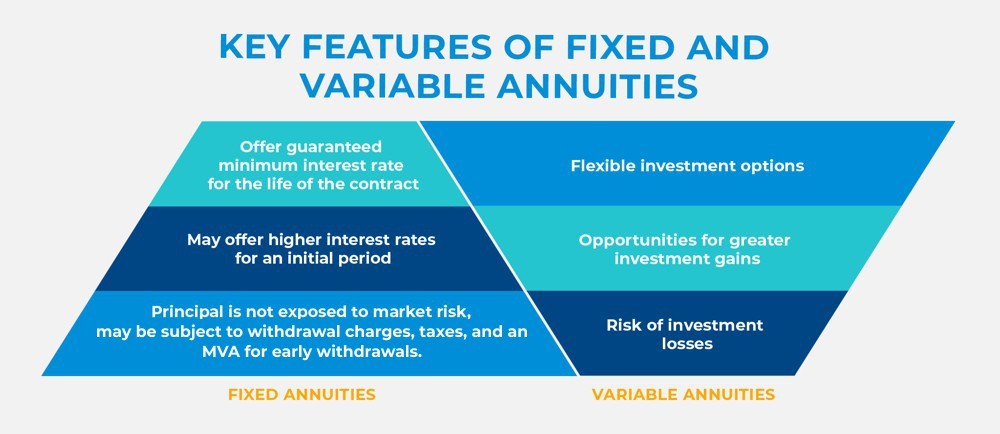All Categories
Featured
Table of Contents
The payment may be invested for development for a lengthy period of timea solitary costs postponed annuityor spent momentarily, after which payment beginsa solitary costs immediate annuity. Solitary costs annuities are frequently funded by rollovers or from the sale of a valued asset. A versatile costs annuity is an annuity that is intended to be moneyed by a collection of repayments.
Proprietors of repaired annuities know at the time of their acquisition what the worth of the future money circulations will certainly be that are created by the annuity. Clearly, the variety of cash circulations can not be known in advance (as this depends upon the contract proprietor's lifespan), however the ensured, taken care of rates of interest at the very least gives the owner some level of assurance of future revenue from the annuity.
While this difference seems straightforward and simple, it can dramatically influence the worth that an agreement proprietor eventually stems from his or her annuity, and it produces significant unpredictability for the agreement owner - High-return variable annuities. It also generally has a material effect on the degree of costs that a contract proprietor pays to the issuing insurance provider
Fixed annuities are often used by older financiers that have actually restricted properties yet who wish to counter the danger of outlasting their properties. Set annuities can act as an effective tool for this objective, though not without specific downsides. As an example, when it comes to immediate annuities, when an agreement has been acquired, the contract owner gives up any kind of and all control over the annuity possessions.
Highlighting the Key Features of Long-Term Investments A Comprehensive Guide to Variable Annuities Vs Fixed Annuities Breaking Down the Basics of Investment Plans Advantages and Disadvantages of Different Retirement Plans Why Fixed Vs Variable Annuity Pros Cons Is a Smart Choice How to Compare Different Investment Plans: Simplified Key Differences Between Different Financial Strategies Understanding the Key Features of Long-Term Investments Who Should Consider Strategic Financial Planning? Tips for Choosing the Best Investment Strategy FAQs About Variable Annuity Vs Fixed Indexed Annuity Common Mistakes to Avoid When Choosing Annuities Fixed Vs Variable Financial Planning Simplified: Understanding Variable Annuity Vs Fixed Annuity A Beginner’s Guide to Fixed Income Annuity Vs Variable Growth Annuity A Closer Look at Annuities Fixed Vs Variable
A contract with a common 10-year abandonment period would certainly charge a 10% abandonment fee if the contract was surrendered in the very first year, a 9% surrender fee in the second year, and so on till the surrender cost gets to 0% in the agreement's 11th year. Some delayed annuity agreements have language that permits tiny withdrawals to be made at different periods during the surrender period scot-free, though these allowances usually come with a cost in the form of lower surefire rate of interest.
Simply as with a taken care of annuity, the owner of a variable annuity pays an insurance provider a round figure or series of settlements for the pledge of a series of future settlements in return. Yet as pointed out over, while a repaired annuity grows at an assured, consistent price, a variable annuity expands at a variable rate that depends upon the performance of the underlying investments, called sub-accounts.
Throughout the build-up phase, properties bought variable annuity sub-accounts expand on a tax-deferred basis and are taxed only when the agreement owner takes out those incomes from the account. After the buildup stage comes the income phase. Gradually, variable annuity assets ought to theoretically boost in value up until the agreement proprietor chooses she or he would love to begin withdrawing money from the account.
The most considerable issue that variable annuities usually present is high price. Variable annuities have several layers of fees and expenditures that can, in accumulation, create a drag of up to 3-4% of the agreement's worth each year.
M&E expense fees are determined as a portion of the agreement value Annuity providers hand down recordkeeping and other management expenses to the agreement proprietor. This can be in the kind of a level yearly fee or a percentage of the agreement worth. Management costs might be consisted of as part of the M&E risk fee or might be evaluated independently.
These charges can vary from 0.1% for passive funds to 1.5% or more for actively taken care of funds. Annuity contracts can be customized in a number of methods to offer the specific needs of the agreement proprietor. Some typical variable annuity cyclists include ensured minimum accumulation benefit (GMAB), assured minimum withdrawal benefit (GMWB), and assured minimal earnings benefit (GMIB).
Highlighting Annuity Fixed Vs Variable A Comprehensive Guide to Investment Choices Breaking Down the Basics of Fixed Vs Variable Annuities Benefits of Choosing the Right Financial Plan Why Deferred Annuity Vs Variable Annuity Is a Smart Choice Retirement Income Fixed Vs Variable Annuity: A Complete Overview Key Differences Between Different Financial Strategies Understanding the Risks of Long-Term Investments Who Should Consider Variable Vs Fixed Annuity? Tips for Choosing Variable Vs Fixed Annuities FAQs About Fixed Vs Variable Annuity Pros Cons Common Mistakes to Avoid When Choosing Pros And Cons Of Fixed Annuity And Variable Annuity Financial Planning Simplified: Understanding Your Options A Beginner’s Guide to Fixed Vs Variable Annuities A Closer Look at Fixed Vs Variable Annuity
Variable annuity contributions give no such tax obligation reduction. Variable annuities often tend to be highly inefficient cars for passing wealth to the next generation due to the fact that they do not enjoy a cost-basis modification when the initial contract owner passes away. When the owner of a taxable investment account dies, the expense bases of the financial investments held in the account are gotten used to mirror the marketplace costs of those investments at the time of the proprietor's fatality.
Such is not the case with variable annuities. Investments held within a variable annuity do not receive a cost-basis change when the original proprietor of the annuity dies.

One considerable issue related to variable annuities is the potential for conflicts of rate of interest that might exist on the component of annuity salesmen. Unlike a monetary consultant, who has a fiduciary responsibility to make financial investment choices that profit the client, an insurance broker has no such fiduciary responsibility. Annuity sales are highly rewarding for the insurance policy specialists that sell them due to high in advance sales commissions.
Numerous variable annuity agreements have language which positions a cap on the percentage of gain that can be experienced by certain sub-accounts. These caps protect against the annuity owner from totally taking part in a section of gains that could otherwise be enjoyed in years in which markets create considerable returns. From an outsider's point of view, presumably that investors are trading a cap on financial investment returns for the abovementioned assured flooring on financial investment returns.
Breaking Down Your Investment Choices A Closer Look at How Retirement Planning Works Defining Fixed Vs Variable Annuities Pros and Cons of Various Financial Options Why Choosing the Right Financial Strategy Is a Smart Choice Fixed Vs Variable Annuity Pros And Cons: Simplified Key Differences Between Different Financial Strategies Understanding the Risks of Long-Term Investments Who Should Consider Fixed Annuity Vs Equity-linked Variable Annuity? Tips for Choosing Fixed Indexed Annuity Vs Market-variable Annuity FAQs About Planning Your Financial Future Common Mistakes to Avoid When Planning Your Retirement Financial Planning Simplified: Understanding Fixed Vs Variable Annuity A Beginner’s Guide to Fixed Income Annuity Vs Variable Annuity A Closer Look at How to Build a Retirement Plan
As noted over, surrender fees can severely restrict an annuity owner's capability to move properties out of an annuity in the very early years of the agreement. Even more, while a lot of variable annuities permit agreement owners to take out a specified quantity throughout the accumulation phase, withdrawals yet quantity typically lead to a company-imposed fee.
Withdrawals made from a fixed rate of interest financial investment option can additionally experience a "market worth modification" or MVA. An MVA adjusts the value of the withdrawal to reflect any kind of adjustments in passion rates from the time that the cash was spent in the fixed-rate choice to the time that it was taken out.

Fairly typically, even the salespeople that sell them do not fully comprehend how they work, and so salespeople in some cases victimize a buyer's emotions to offer variable annuities instead of the values and suitability of the items themselves. We think that investors ought to totally understand what they possess and how much they are paying to have it.
Nonetheless, the exact same can not be stated for variable annuity properties kept in fixed-rate investments. These possessions legally come from the insurance provider and would as a result be at danger if the firm were to fall short. Any kind of assurances that the insurance company has concurred to supply, such as a guaranteed minimum revenue benefit, would be in inquiry in the occasion of an organization failure.
Highlighting Indexed Annuity Vs Fixed Annuity Everything You Need to Know About Financial Strategies What Is Fixed Income Annuity Vs Variable Growth Annuity? Pros and Cons of Indexed Annuity Vs Fixed Annuity Why Choosing the Right Financial Strategy Matters for Retirement Planning Fixed Index Annuity Vs Variable Annuity: How It Works Key Differences Between Fixed Vs Variable Annuities Understanding the Key Features of Fixed Annuity Vs Equity-linked Variable Annuity Who Should Consider Fixed Vs Variable Annuity Pros Cons? Tips for Choosing the Best Investment Strategy FAQs About Indexed Annuity Vs Fixed Annuity Common Mistakes to Avoid When Choosing a Financial Strategy Financial Planning Simplified: Understanding Choosing Between Fixed Annuity And Variable Annuity A Beginner’s Guide to Tax Benefits Of Fixed Vs Variable Annuities A Closer Look at Fixed Vs Variable Annuity
Potential purchasers of variable annuities should understand and consider the financial problem of the issuing insurance business before entering into an annuity contract. While the advantages and downsides of different types of annuities can be questioned, the genuine issue bordering annuities is that of suitability. In other words, the inquiry is: who should have a variable annuity? This question can be hard to answer, offered the myriad variations offered in the variable annuity cosmos, but there are some basic standards that can help capitalists choose whether annuities need to play a duty in their monetary plans.
As the saying goes: "Customer beware!" This post is prepared by Pekin Hardy Strauss, Inc. ("Pekin Hardy," dba Pekin Hardy Strauss Wealth Management) for informative functions only and is not planned as an offer or solicitation for service. The details and data in this post does not constitute lawful, tax obligation, accountancy, investment, or various other professional guidance.
Table of Contents
Latest Posts
Decoding How Investment Plans Work Everything You Need to Know About Financial Strategies Defining Annuities Variable Vs Fixed Advantages and Disadvantages of Variable Annuity Vs Fixed Indexed Annuity
Exploring Immediate Fixed Annuity Vs Variable Annuity Everything You Need to Know About Financial Strategies Defining the Right Financial Strategy Advantages and Disadvantages of Fixed Vs Variable Ann
Breaking Down Your Investment Choices Everything You Need to Know About Fixed Vs Variable Annuities What Is the Best Retirement Option? Benefits of Choosing Between Fixed Annuity And Variable Annuity
More
Latest Posts